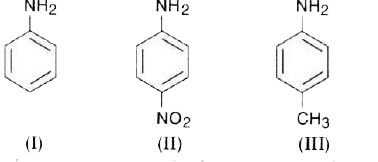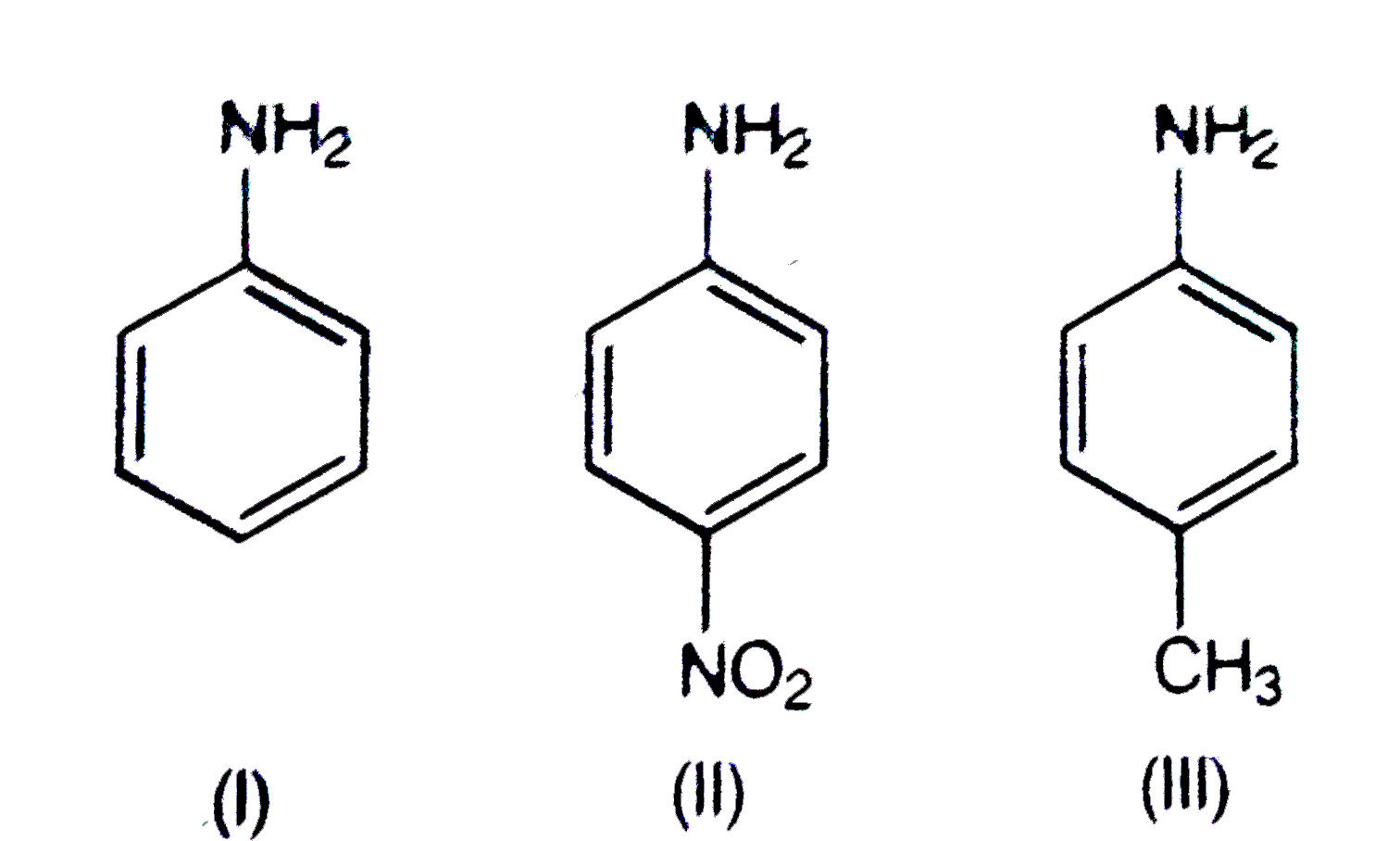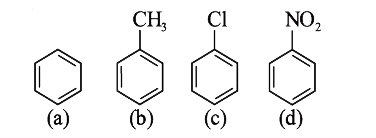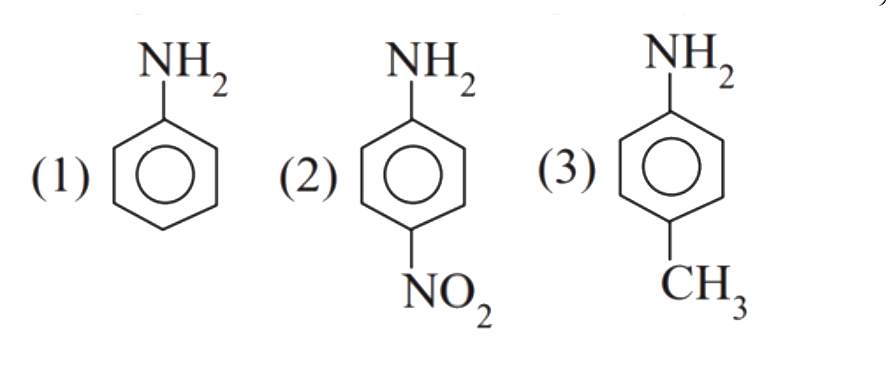Increasing order of electrophilic substitution for following compounds:
IV<I<II<III
III>II>I>IV
I>IV>III>II
II>III>I>IV
The correct Answer is:A
To determine the increasing order of electrophilic substitution reactions for the given compounds, we need to analyze the substituents attached to the benzene ring and their effects on the rate of the electrophilic substitution reaction. Here’s a step-by-step solution:
Step 1: Identify the Compounds and Their Substituents
We need to identify the substituents on the benzene rings for the four compounds provided. Let's assume the compounds are as follows:
1. Compound 1: No substituent (C6H6)
2. Compound 2: CH3 (methyl group)
3. Compound 3: OCH3 (methoxy group)
4. Compound 4: CF3 (trifluoromethyl group)
Step 2: Understand the Effect of Substituents
- Electron Donating Groups (EDGs): These groups increase the electron density on the benzene ring, stabilizing the sigma complex formed during electrophilic substitution. Examples include alkyl groups (like CH3) and groups that can donate electrons through resonance (like OCH3).
- Electron Withdrawing Groups (EWGs): These groups decrease the electron density on the benzene ring, destabilizing the sigma complex and slowing down the reaction. An example is CF3.
Step 3: Rank the Compounds Based on Substituent Effects
1. Compound 4 (CF3): This is an electron-withdrawing group, which will deactivate the benzene ring and slow down the electrophilic substitution reaction.
2. Compound 1 (No substituent): The absence of any substituent means the benzene ring is neutral, leading to a moderate rate of electrophilic substitution.
3. Compound 2 (CH3): The methyl group is an electron-donating group through hyperconjugation, which increases the rate of electrophilic substitution compared to the unsubstituted benzene.
4. Compound 3 (OCH3): The methoxy group donates electrons through resonance, which is more effective than hyperconjugation, making this compound the most reactive towards electrophilic substitution.
Step 4: Write the Increasing Order of Electrophilic Substitution
Based on the analysis:
- Compound 4 (CF3) < Compound 1 (No substituent) < Compound 2 (CH3) < Compound 3 (OCH3)
Thus, the increasing order of electrophilic substitution is:
4 < 1 < 2 < 3
Final Answer
The correct answer is: 4, 1, 2, 3
---
We need to identify the substituents on the benzene rings for the four compounds provided. Let's assume the compounds are as follows:
1. Compound 1: No substituent (C6H6)
2. Compound 2: CH3 (methyl group)
3. Compound 3: OCH3 (methoxy group)
4. Compound 4: CF3 (trifluoromethyl group)
- Electron Donating Groups (EDGs): These groups increase the electron density on the benzene ring, stabilizing the sigma complex formed during electrophilic substitution. Examples include alkyl groups (like CH3) and groups that can donate electrons through resonance (like OCH3).
- Electron Withdrawing Groups (EWGs): These groups decrease the electron density on the benzene ring, destabilizing the sigma complex and slowing down the reaction. An example is CF3.
1. Compound 4 (CF3): This is an electron-withdrawing group, which will deactivate the benzene ring and slow down the electrophilic substitution reaction.
2. Compound 1 (No substituent): The absence of any substituent means the benzene ring is neutral, leading to a moderate rate of electrophilic substitution.
3. Compound 2 (CH3): The methyl group is an electron-donating group through hyperconjugation, which increases the rate of electrophilic substitution compared to the unsubstituted benzene.
4. Compound 3 (OCH3): The methoxy group donates electrons through resonance, which is more effective than hyperconjugation, making this compound the most reactive towards electrophilic substitution.
Based on the analysis:
- Compound 4 (CF3) < Compound 1 (No substituent) < Compound 2 (CH3) < Compound 3 (OCH3)
4 < 1 < 2 < 3
The correct answer is: 4, 1, 2, 3
Similar Questions
Knowledge Check
- Question 1 - Select One
The correct increasing order of basic strength for the following compound is
 AII lt IIIlt IBIII lt Ilt IICIII lt IIlt IDII lt I lt III.
AII lt IIIlt IBIII lt Ilt IICIII lt IIlt IDII lt I lt III. - Question 2 - Select One

Decreasing order of rate of electrophilic aromatic substitution is : (Aa gt b gt c gt dBa gt c gt b gt dCb gt a gt c gt dDb gt c gt a gt d
Identify the correct order of reactivity in electrophilic substitution reactions of the following compounds :
 View Solution
View SolutionIdentify the correct of reactivity in electrophilic substitution reaction of the following compounds.
(1) Benzene
(2) Toluene
(3) Chlorobenzene,
(4) Nitrobenzene.View SolutionArrange reactivity of given compounds in decreasing order for electrophilic substitution reaction
1. Furan
2. Pyrrole
3. ThiopheneView SolutionThe correct increasing order is basic strength for the following compounds is…
 View Solution
View SolutionIncreasing order of the following for electrophilic substitution reaction as -
_E01_194_Q01.png) View Solution
View SolutionArrange following compounds in decreasing order of rate of electrophilic substitution.
 View Solution
View Solution



